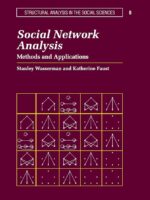Analyzing Social Networks Review
Analyzing Social Networks by Stephen P. Borgatti, Martin G. Everett, and Jeffrey C. Johnson is a practical, software-aware introduction to SNA: from data collection to metrics, models, and interpretation. It bridges theory and button-click workflows without dumbing down concepts.
Overview
The book covers network types and data structures, centrality, cohesion, positions and roles, two-mode networks, community detection, visualization, and basic statistical models. Examples use common tools (UCINET, Gephi, R) with replicable steps.
Summary
You learn to define nodes and ties, design surveys, clean edge lists, and choose measures that match questions. Chapters detail degree, betweenness, closeness, eigenvector centrality; cliques and k-cores; blockmodeling; bipartite projections; and permutation-based inference that respects dependence.
Authors
Borgatti, Everett, and Johnson are field leaders who teach with clarity and field-tested examples. Their style is pragmatic and method-first.
Key Themes
Fit measures to mechanisms; beware sampling bias; visualize to hypothesize, model to verify; treat networks as data with dependencies.
Strengths and Weaknesses
Strengths: hands-on guidance, clear metric explanations, and software pointers. Weaknesses: limited depth on cutting-edge models and dynamic networks. Use as a working primer.
Target Audience
Students, researchers, and analysts who need to run real SNA projects with credible methods and transparent outputs.
Favorite Ideas
Task-to-metric mapping; permutation tests for centrality differences; two-mode designs that avoid projection pitfalls.
Takeaways
Define ties carefully, collect clean data, pick measures that match your hypothesis, and use permutation-friendly inference. Good SNA is disciplined, not just pretty graphs.





